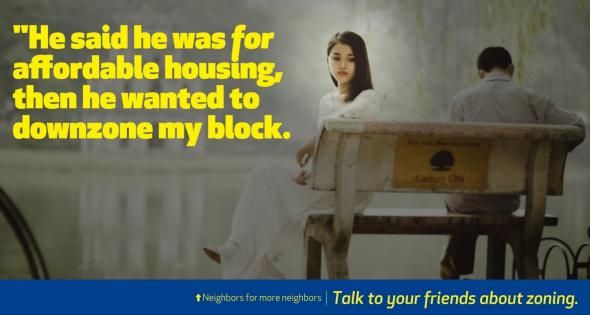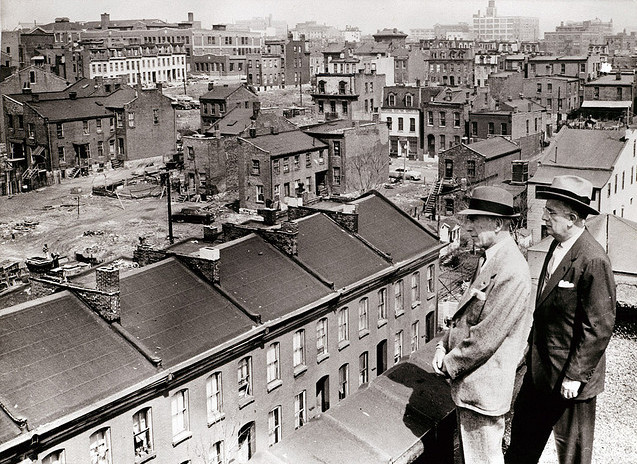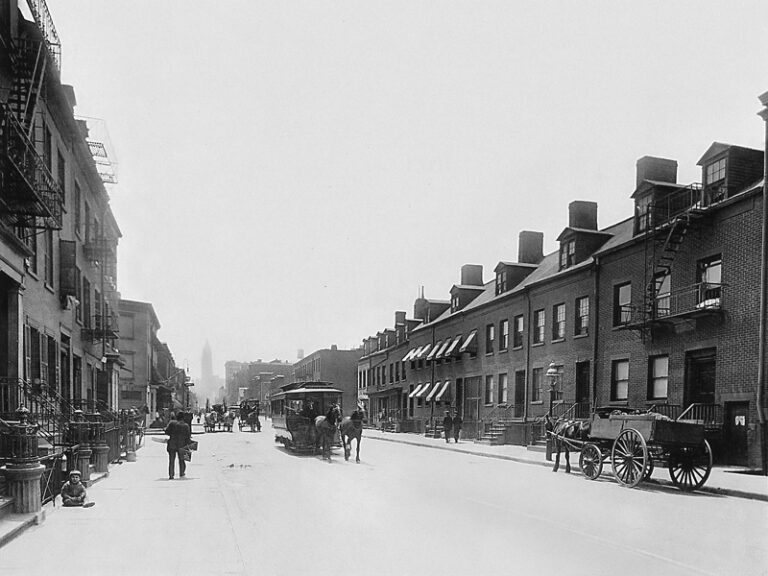Physical Address
304 North Cardinal St.
Dorchester Center, MA 02124
Physical Address
304 North Cardinal St.
Dorchester Center, MA 02124
A blog post in Pacific Standard seeks to defend rent control- an idea that, as the author admits, is generally detested by economists. The author writes that “rent regulations give tenants a greater stake in their community and incentivize them to put time, energy, and even money into their homes.” But that’s not necessarily a good thing- in a heavily regulated market, a “stake in the community” means that tenants, like homeowners, have an incentive to engage in NIMBYism. So in a prosperous area rent control hits housing supply with a double whammy- more recruits for the NIMBY army AND less incentive for landlords to invest in housing. He also endorses the “Unlimited Demand” theory, acknowledging the argument that building more market rate housing creates more affordable housing eventually, but responds: “not in tight markets like Silicon Valley and New York City. ” This claim is of course a self-fulfilling prophecy: people use it to justify opposing new housing, which in turn ensures that supply can never meet demand. (I critique the argument in more detail here). However, the article does contain one non-silly argument: that rent-controlled cities do occasionally experience building booms (most notably New York in the 1950s). Rent control is a factor relating to housing supply, but not the only one. So here’s my modest proposal for pro-regulation politicians: a city can adopt rent control to protect existing tenants, as long as they deregulate in other ways in order to promote new construction. So for example, a state law could provide that municipalities could adopt rent control under one condition: no more exclusion of new housing. So if San Mateo County wants to adopt rent control, they can do it as long as all new housing is exempt from all of the city’s use and density restrictions. The […]

The far-left “TruthOut” web page recently published an attack on YIMBYs,* describing them as an “Alt-Right” group (despite the fact that the Obama Administration is pro-YIMBY). I was surprised how little substance there was to the article; most of it was various ad-hominem attacks on YIMBY activists for cavorting with rich people. I only found two statements that even faintly resembled rational arguments. First, the article suggests that only current residents’ interests are worth considering in zoning policy, because “the people who haven’t yet moved in” most often means the tech industrialists, lured by high salaries, stock options and in-office employee benefits like massage therapists and handcrafted kombucha.” This statement is no different than President Trump’s suggestion that Mexican immigrants “[are] bringing drugs. They’re bringing crime. They’re rapists.” – that is, it is an unverifiable (if not bigoted) generalization about large numbers of people. Furthermore, it doesn’t make sense. The “tech industrialists” have the money to outbid everyone else, so they aren’t harmed by restrictive zoning. Second, the article states that academic papers aren’t as relevant as the actual experiences of San Franciscans displaced by high housing costs. In response to the argument that less regulation means cheaper housing, it states “tell that to people like Iris Canada, the 100-year-old Black woman who had used local regulations to stay in her home of six decades, only to be evicted in February.” So in other words, somebody was evicted in San Francisco, therefore San Francisco’s restrictive zoning prevents eviction. I don’t see how the latter follows from the former. The whole point of the YIMBY/market urbanist argument is that if there was more housing, there would be lower housing costs, hence fewer evictions. *For those of you who are unfamiliar with the term, YIMBY means “Yes In My Back Yard”, a […]

Lexington, Kentucky is a wonderful place, and that’s getting to be a problem. There’s nothing intrinsically wrong with the city: its urban amenities, thriving information economy, and unique local culture have brought in throngs of economic migrants from locales as exotic as Appalachia, Mexico, and the Rust Belt. The problem, rather, is that the city isn’t zoned to support this newfound attention. Over the past five years, the city has grown by an estimated 18,000 residents, putting Lexington’s population at approximately 314,488. Lexington has nearly tripled in size since 1970 and the trend shows no signs of stopping, with an estimated 100,000 new residents arriving by 2030. Despite this growth, new development has largely lagged behind: despite the boom in new residents, the city has only permitted the construction of 6,021 new housing units over the past five years—not an awful ratio when compared to a San Francisco, but still putting us firmly on the path toward shortages. The lion’s share of this new development has taken the form of new single-family houses on the periphery of town. Create your own infographics. Sources: ACS/Census Bureau At the risk of sounding like a broken record, there’s nothing intrinsically wrong with single-family housing on the periphery of town. Yet in the case of Lexington, it’s suspect as a sustainable source of affordable housing. Lexington was the first American city to adopt an urban growth boundary (UGB), a now popular land-use regulation that limits outward urban expansion. As originally conceived, the UGB program isn’t such a bad idea: the city would simultaneously preserve nearby farmland and natural areas (especially important for Lexington, given our idyllic surrounding countryside) while easing restrictions on infill development. Create your own infographics. Source: Census Bureau The trouble with Lexington is that the city has undertaken […]

Planners, like all professions, have their own useful mythologies. A popular one goes something like this: “Many years ago, us planners did naughty things. We pushed around the poor, demolished minority neighborhoods, and forced gentrification. But that’s all over today. Now we protect the disadvantaged against the vagaries of the unrestrained market.” The seasoned—which is to say, cynical—planner may knowingly roll her eyes at this story, but for the true believer, this story holds spiritual significance. By doing right today, the reasoning goes, planners are undoing the horrors of yesterday. This raises the question: are planners doing right today? That’s not at all clear. Just ask Hinga Mbogo. After emigrating from Kenya, Mr. Mbogo opened Hinga’s Automotive in East Dallas in 1986. Mr. Mbogo’s modest business is precisely the kind of thing cities need, providing a service for the community, taxes for the city, and blue-collar jobs. While perhaps not of the “creative class,” Mr. Mbogo and his small business represent the type of creative little plan that cities cultivate and depend on. Hinga’s Automotive has thrived for 19 years and looked primed for another 19. Unfortunately for Mr. Mbogo, Dallas planners had other plans. In 2005, the city rezoned the area to prohibit auto-related businesses. While rezonings—particularly upzonings—aren’t necessarily a bad thing, Dallas planners opted to force their vision through and implemented a controversial planning technique known as “amortization.” Normally when planners rezone an area, they allow existing uses that run afoul of the new code to continue operating indefinitely. These are known as “non-conforming uses” and they’re common in neighborhoods across the country, often taking the form of neighborhood groceries, restaurants, and small industrial shops. Yet under amortization, the government forces non-conforming uses to cease operating without any compensation. In the case of Hinga’s Automotive, this means […]
[Research help for this article was provided by UCLA student Mitchell Boswell] The past 15 years have seen a hell of a lot of gentrification in LA. 15% of our poor neighborhoods have undergone gentrification since the year 2000, and it feels like things have only accelerated since the end of the financial crisis. That’s putting a huge strain on communities across the city, from Boyle Heights to Leimert Park. But before we get into why, let’s get one thing out of the way… Academics love to debate about whether gentrification is good or bad for residents of poor neighborhoods. Maybe we should try listening to what people actually want. Some argue that when a neighborhood gentrifies, more of the existing residents stay in the neighborhood than they otherwise would (one of the many, many hard things about poverty is housing insecurity, so folks tend to move around a lot no matter what), and also tend to be more satisfied after the change. On the other side of the debate are people arguing that as gentrification occurs, the investment and new residents push up rent prices and drive out poor residents who made that community home. It’s not clear who’s right. That all seems pretty academic – it’s an argument between folks who are well-off about whether or not people in poor neighborhoods should be happy. Instead of telling people how they should feel, maybe we should stop and listen, just for a minute, to what they want. And a lot of those people sure as hell don’t seem to want gentrification. The lack of new housing on the Westside is driving gentrification There are a lot of reasons for gentrification, but the lack of new housing on the Westside deserves a lot of the blame in recent years. As […]

Gentrification is the result of powerful economic forces. Those who misunderstand the nature of the economic forces at play, risk misdirecting those forces. Misdirection can exasperate city-wide displacement. Before discussing solutions to fighting gentrification, it is important to accept that gentrification is one symptom of a larger problem. Anti-capitalists often portray gentrification as class war. Often, they paint the archetypal greedy developer as the culprit. As asserted in jacobin magazine: Gentrification has always been a top-down affair, not a spontaneous hipster influx, orchestrated by the real estate developers and investors who pull the strings of city policy, with individual home-buyers deployed in mopping up operations. Is Gentrification a Class War? In a way, yes. But the typical class analysis mistakes the symptom for the cause. The finger gets pointed at the wrong rich people. There is no grand conspiracy concocted by real estate developers, though it’s not surprising it seems that way. Real estate developers would be happy to build in already expensive neighborhoods. Here, demand is stable and predictable. They don’t for a simple reason: they are not allowed to. Take Chicago’s Lincoln Park for example. Daniel Hertz points out that the number of housing units in Lincoln Park actually decreased 4.1% since 2000. The neighborhood hasn’t allowed a single unit of affordable housing to be developed in 35 years. The affluent residents of Lincoln Park like their neighborhood the way it is, and have the political clout to keep it that way. Given that development projects are blocked in upper class neighborhoods, developers seek out alternatives. Here’s where “pulling the strings” is a viable strategy for developers. Politicians are far more willing to upzone working class neighborhoods. These communities are far less influential and have far fewer resources with which to fight back. Rich, entitled, white areas get down-zoned. Less-affluent, disempowered, minority […]

Co-authored with Anthony Ling, editor at Caos Planejado Gentrification Gentrification is the process through which real estate becomes more valuable and, therefore, more expensive. Rising prices displace older residents in favor of transplants with higher incomes. This shouldn’t be confused with the forced removal of citizens via eminent domain or “slum clearance.” Ejecting residents by official fiat is a different problem entirely. A classic example of gentrification is that of Greenwich Village, New York. Affluent residents initially occupied the neighborhood. It later became the city’s center for prostitution, prompting an upper-middle class exodus. Low prices and good location would later attract the textile industry. This was the neighborhood’s first wave of gentrification. But after a large factory fire, the neighborhood was once again abandoned. Failure, however, would give way to unexpected success: artists and galleries began to occupy the vacant factories. These old industrial spaces soon became home to one of the most important movements in modern art. In Greenwich Village, different populations came and went. And in the process they each made lasting contributions to New York’s economic and cultural heritage. This was only possible because change was allowed to take place. But change isn’t always easy. As a neighborhood becomes more popular, it also becomes more expensive. Tensions run high when long-time residents can’t afford rising rents. Some begin to call for rent controls or other measures to prevent demographic churn. But rent control is a temporary fix at best; in the longer term, its effects are negative. By reducing supply, rent control tends to drive up the cost of housing. And in the face of price controls, landlords may seek to exit the rental market entirely, further exacerbating any housing shortage. What, then, does this mean for urban development? How can cities evolve without completely displacing their middle and […]
Lydia DePillis wrote the Washington City Paper’s cover story on the case for Congress overturning DC’s height limit, which should be very familiar to readers of this blog. It’s got some interesting history in it (DC’s height limit was apparently influenced by George Washington’s personal aesthetics, despite the fact that he never governed from the city), but the part that was really interesting to me was the part where she discusses what the new limitations should be. It’s not politically practical to advocate for lifting the limit without reservations, as we here would like, and there are the usual caveats and equivocations (“What if additional height were granted on a competitive basis, and awarded for the best design?”). But the part that really stood out to me was this graphic (click on the image and scroll to the bottom of the linked page to see a bigger version), outlining where Lydia thinks the height restrictions should be lifted: Anyone familiar with DC geography will notice that the area most insulated from change – Northwest DC – is the richest part of town, full of desirable white neighborhoods. The areas where DePillis advocates lifting the height limit – neighborhoods east of the Anacostia River figure prominently in the graphic – are far blacker and poorer than the rest of DC. Sure, there are pretty buildings in NW and a lot of ugly ones in Anacostia, but there are also beautiful homes off of Benning Road and shitty ones in Burleith. (Which, I should add, could desperately use some taller buildings, given its proximity to the perpetually housing-strapped Georgetown University and its rather ugly architecture compared to Georgetown proper.) This tactic of upzoning poor black neighborhoods while leaving white neighborhoods unchanged is very common, and I realize that Lydia is just trying […]